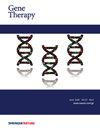AAV library screening identifies novel vector for efficient transduction of human aorta
IF 4.5
3区 医学
Q1 BIOCHEMISTRY & MOLECULAR BIOLOGY
引用次数: 0
Abstract
Targeted gene delivery to vascular smooth muscle cells (VSMCs) could prevent or improve a variety of diseases affecting the vasculature and particularly the aorta. Thus, we aimed to develop a delivery vector that efficiently targets VSMCs. We selected engineered adeno-associated virus (AAV) capsids from a random AAV capsid library and tested the top enriched motifs in parallel screening through individual barcoding. This approach allowed us to distinguish capsids that only transduce cells based on genomic DNA (gDNA) from those also mediating transgene expression based on transcribed cDNA reads. After three rounds of selection on primary murine VSMCs (mVSMCs), we identified a novel targeting motif (RFTEKPA) that significantly improved transduction and gene expression efficiency over AAV9-wild type (WT) and increased expression in mVSMCs by 70% compared to the previously identified SLRSPPS peptide. Further analysis showed that the novel motif also improved expression in human aortic smooth muscle cells (HAoSMCs) and human aortic tissue ex vivo up to threefold compared to SLRSPPS and approximately 70-fold to AAV9-WT. This high cross-species transduction efficiency makes the novel capsid motif a potential candidate for future clinical application in vascular diseases.

AAV文库筛选为人类主动脉高效转导找到了新的载体。
靶向基因传递到血管平滑肌细胞(VSMCs)可以预防或改善多种影响血管系统特别是主动脉的疾病。因此,我们的目标是开发一种有效靶向vsmc的递送载体。我们从随机的AAV衣壳库中选择工程化腺相关病毒(AAV)衣壳,并通过单独的条形码平行筛选测试了最富集的基序。这种方法使我们能够区分仅基于基因组DNA (gDNA)转导细胞的衣壳和基于转录的cDNA reads介导转基因表达的衣壳。在对原代小鼠VSMCs (mVSMCs)进行三轮筛选后,我们发现了一个新的靶向基序(RFTEKPA),该基序显著提高了aav9野生型(WT)的转导和基因表达效率,与先前鉴定的SLRSPPS肽相比,在mVSMCs中的表达增加了70%。进一步分析表明,与SLRSPPS相比,新基序在人主动脉平滑肌细胞(HAoSMCs)和人主动脉组织中的体外表达提高了3倍,比AAV9-WT提高了约70倍。这种高的跨物种转导效率使新的衣壳基序成为未来血管疾病临床应用的潜在候选者。
本文章由计算机程序翻译,如有差异,请以英文原文为准。
求助全文
约1分钟内获得全文
求助全文
来源期刊

Gene Therapy
医学-生化与分子生物学
CiteScore
9.70
自引率
2.00%
发文量
67
审稿时长
4-8 weeks
期刊介绍:
Gene Therapy covers both the research and clinical applications of novel therapeutic techniques based on a genetic component. Over the last few decades, significant advances in technologies ranging from identifying novel genetic targets that cause disease through to clinical studies, which show therapeutic benefit, have elevated this multidisciplinary field to the forefront of modern medicine.
 求助内容:
求助内容: 应助结果提醒方式:
应助结果提醒方式:


